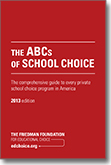 Forty-six years ago a plaintiff named John Serrano sued the State of California, asserting that the capacity of school districts to raise money was grossly unequal, hence unconstitutional. The quality of education in property-poor districts was said to be diminished by the resulting disparities in spending per pupil. Students had a right to a more rational and fair distribution of money.
Forty-six years ago a plaintiff named John Serrano sued the State of California, asserting that the capacity of school districts to raise money was grossly unequal, hence unconstitutional. The quality of education in property-poor districts was said to be diminished by the resulting disparities in spending per pupil. Students had a right to a more rational and fair distribution of money.
As in most litigation the claimants had to prove some real injury. The disparities in spending were colossal, ranging, at the extremes, from a few hundred dollars per pupil in property-poor districts, to several thousand in freakishly wealthy industrial centers and top-rank suburbs. The injury seemed self-evident.
But it wasn’t. By whichever measure of outcome - graduation, test scores, reputation - there was no pattern linking spending to actual quality. In addition, surprisingly, there was little or no evidence that children from poor families were systematically getting less spent on their schools. The lawyers for Serrano et al. could not credibly assert that money was the key to quality education or indeed, that it affected the success of schools in any way - except one. It was obviously true that the richer districts could buy more stuff. They could hire more teachers, administrators and superintendents, at higher salaries, build fancier buildings and secure the most up-to-date supplies, books and equipment. The trial judge decided this was injury enough. His judgment for the plaintiffs was affirmed by the California Supreme Court. As yet, however, 40 years later, no one has succeeded in establishing a clear link between spending per-pupil and the benefit for the child.
Nevertheless, spending has skyrocketed in succeeding generations across the nation for reasons political - principally the monopoly power of public-service unions. But the apparent disconnect between spending and quality of education remains. This reality has conflicting implications for the school choice movement. It reduces the political significance of the consistent discrimination in spending against today’s charter schools; we are not at all clear that it really affects outcome. On the other hand, it is plain to anyone who knows the facts that, whatever it is that does make a school successful, it can be had without exploding the cost. In short, if school choice supporters are willing to accept and even exploit politically the cheaper regimes now in place, they have a more powerful case. (more…)

Despite the charge of uneven playing fields, it's charter schools and tax credit scholarships that face the greatest financial imbalances in Florida education.
With Florida now spending less per student than it did six years ago and less than at least three-fourths of the states, there is plausible case to be made for giving public education a raise. But Kathleen McGrory’s recent story on the status of a 2009 education adequacy lawsuit is a reminder that fiscal beauty is often in the eye of the beholder.
Let’s parse two of the claims in the suit:
The state is not putting up its fair share. In Florida, K-12 public education is funded by a combination of local and state taxes under a formula known as the Florida Education Finance Program. The complaint, filed four years ago, noted the state portion had dropped from 62 to 44 percent over the previous nine years. But that dramatic trend has made a similarly dramatic turn. This year, the state portion is back up to 57 percent – 58 percent if you count the state money spent on a scholarship for low-income students. This should ostensibly satisfy one of the major claims in the lawsuit. But the plaintiffs, which include Citizens for Strong Schools and Fund Education Now, are not likely be satisfied. The reason is the amount spent per student has remained basically unchanged – $6,873 in 2009-10 and $6,779 in 2013-14.
Charter schools and other options should be held to the same standards. It’s not entirely clear why a lawsuit aiming to enforce a constitutional provision requiring “adequate provision” for a “high quality” school system would take aim at learning options that are increasingly popular with Florida parents. But one of the attorneys, Neil Chonin, told McGrory that an important principle is at stake: “Our position is that there should be an even playing field.”
In a suit about financial resources, that’s a curious line to draw. (more…)
In today's chat, we talked with Doug Tuthill, president of Step Up For Students in Florida.
Readers asked him about everything from Common Core and private schools, to whether the value of tax credit scholarships should be increased, to the right balance between school choice and government regs when it comes to accountability.
Step Up is the largest private school choice program in the country. It’s expected to serve 60,000 students this fall. And as recent news stories have pointed out, it continues to experience strong growth. (Step Up also co-hosts this blog with the American Center for School Choice. As we noted in the advance post, we strive not to be self-promotional but in this case thought it was appropriate to feature Doug.)
Before joining Step Up in 2008, Doug had been a college professor, a classroom teacher, the president of two teachers unions and a driving force behind the creation of Florida's first International Baccalaureate high school.
You can replay the chat here:
Editor's note: This op-ed was published on the Raleigh News & Observer website last night.
The debate over a private learning option for poor schoolchildren in North Carolina has a familiar ring to it because Florida faced similar fears a dozen years ago. But a targeted and accountable scholarship can strengthen our commitment to equal educational opportunity by giving more tools to the students who face the greatest odds.
Don’t trust me, a lifelong progressive Democrat and former teacher union president who now leads the nation’s largest scholarship program for low-income students. Look instead at the track record in a state with a scholarship that is similar to the plan being offered by a bipartisan coalition of N.C. House members. The Florida Tax Credit Scholarship can provide at least a few answers:
The scholarship serves the students who struggle the most. Scholarship opponents say that the most disadvantaged students are the most likely to remain in public schools. But the experience in Florida is just the opposite. As the state’s independent researcher noted in the latest report: “Program participants tend to come from lower-performing public schools prior to entering the program. Likewise, as in prior years, they tend to be among the lowest-performing students in their prior school.”
• These same students are making solid academic progress. According to the results of their nationally norm-referenced tests, these students who were losing ground prior to choosing the scholarship are now achieving the same gains in math and reading each year as students of all income levels nationally. “In other words,” said the latest report, “the typical student participating in the program gained a year’s worth of learning in a year’s worth of time.”
• Traditional public schools are not hurt financially. One N.C. community organizer recently wrote: “At their core, vouchers are about taking public money and giving it to private schools.” But in Florida, five different independent agencies over the past decade have reached the same conclusion: The scholarship saves tax money that can help public schools. That’s because the scholarship is substantially less than the cost of public education, and most of its recipients would have otherwise attended public school. The Florida Revenue Estimating Conference pegged the savings this year at $57.9 million. (more…)
In a blog entry last week, “I’m rethinking my opposition to school vouchers. Convince me,” Nicole Stockdale, the assistant editorial page editor at the Dallas Morning News, said she is grappling with whether to support school vouchers.
What stimulated Nicole’s dilemma is a bill in the Texas Legislature to allow low-income families to use tax credit scholarships (often referred to as school vouchers) to pay private school tuition and fees. She deserves a serious reply to her challenge, and, given I am president of a Florida nonprofit that administers the country’s largest tax credit scholarship program for low-income children, I thought I’d try.
Nicole identified three traditional anti- school vouchers arguments she wanted help refuting:
By allowing low-income students to have the same schooling options as more affluent students aren’t we delaying the process of improving ineffective district schools?
This is not an either-or proposition. All schools should be engaged in continual improvement, but this is not a rationale for denying low-income families access to additional schooling options.
Researchers studying Florida’s tax credit scholarship program found urban district schools improved when our program was first introduced. They hypothesized that the possibility of losing students caused these district schools to focus more attention on meeting the needs of low-income students. This same study also found the district schools most impacted by the loss of scholarship students - Florida now has about 51,000 high-poverty students on scholarship - had proportionally higher test score gains among their own low-income students.
So in Florida we’ve found that both the low-income students on scholarship and the low-income students who remain in district schools are improving at the same time. This finding confirms that different students are successful in different environments, that there is no one-size-fits-all solution for helping students learn. The relationship between the school and the child is the key. That’s why allowing all parents - including low-income parents - to match their children with the schools that best meet their needs is so necessary.
What about students who don’t choose to attend magnet, charter or private schools? Will we end up with non-magnet district schools comprised only of students from apathetic families?
Researchers have found Florida’s tax credit scholarships attract some of the state’s highest poverty and lowest-performing students. In essence, our program does the opposite of creaming. (more…)
 The Friedman Foundation’s latest “ABCs of School Choice” guide is out, and the numbers go like this: 21 states, 39 programs, 255,000 kids.
The Friedman Foundation’s latest “ABCs of School Choice” guide is out, and the numbers go like this: 21 states, 39 programs, 255,000 kids.
The guide offers a state-by-state rundown of the publicly funded, school choice options that are a vital piece of the overall school choice picture. It includes profiles of the students, parents and teachers who benefit from them. And it presents some thought-provoking stats, like how the value of each choice option compares to per-pupil funding in traditional public schools.
In Florida, a tax credit scholarship for low-income students is 34 percent of what’s spent on a traditional public school student, according to the Friedman analysis. Our own back-of-the-envelope calculations would put the percentage slightly higher, but the point is spot on: “voucher” students receive far less for their education than their public school peers. It’s a relevant detail that deserves more attention as the debate unfolds over testing for scholarship students and regulatory accountability measures for the private schools that enroll them.
The Florida section of the guide also includes a mini-profile of Davion Manuel-McKenney, a former tax-credit scholarship student who is now a freshman at Florida State College at Jacksonville. (Full disclosure: the tax-credit program is administered by Step Up For Students, which co-hosts this blog.) The story of Davion and his mother is a moving one. Click here to read more about it.
by Darla Romfo
When Children’s Scholarship Fund received 1.25 million applications for the first 40,000 CSF scholarships in 1999, it became painfully obvious that many parents were unhappy with their assigned public school and were demanding better educational alternatives. That demand for better choices hasn’t changed; every day, we continue to hear from parents who want the chance to make a different school choice.
 Even with the rise in the number of charter schools and the expansion of public school choice, too many families still live in neighborhoods with limited options and poorly performing traditional public schools. Like many more affluent parents, they recognize that providing their children with a good education would put them on the path to future success and security. But they simply cannot afford to move to a good public school district, or choose a private school.
Even with the rise in the number of charter schools and the expansion of public school choice, too many families still live in neighborhoods with limited options and poorly performing traditional public schools. Like many more affluent parents, they recognize that providing their children with a good education would put them on the path to future success and security. But they simply cannot afford to move to a good public school district, or choose a private school.
At the same time, many private schools – especially lower-cost inner-city private schools – have empty seats available. These private schools often operate on a fraction of what nearby public schools spend per student, yet they have higher graduation rates and test scores. The only thing standing between a child in an underperforming school and an empty seat in a private school is funding for a scholarship. While scholarship organizations across the country work hard to raise private funding, if more tax credit or voucher programs were adopted, many more parents could afford to move their children to schools where they could get a safe, quality education.
Parents need good information to make good school choices, too. When given the option to choose a private school, or a public charter school, families unfamiliar with evaluating and comparing schools often find the selection process confusing and frustrating. If parents are to be truly empowered to choose, they need to be better informed.
While many schools (and some schools districts) are open about sharing test scores and other metrics online, more transparency is needed – especially from private schools. (more…)